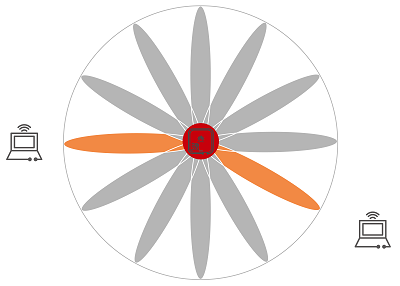Smart antennas
Published:
 Smart antennas are a type of antenna that are used in wireless communication systems to improve the performance of the communication. They are called “smart” because they use advanced algorithms and techniques to adapt the radiation pattern of the antenna in real-time based on the communication environment and the specific needs of the system. Smart antennas are used in a wide range of applications, including cellular communication systems, satellite communication systems, and radar systems.
Smart antennas are a type of antenna that are used in wireless communication systems to improve the performance of the communication. They are called “smart” because they use advanced algorithms and techniques to adapt the radiation pattern of the antenna in real-time based on the communication environment and the specific needs of the system. Smart antennas are used in a wide range of applications, including cellular communication systems, satellite communication systems, and radar systems.
There are several types of smart antenna technologies, including adaptive array antennas, switched beam antennas, and beamforming antennas. Adaptive array antennas use multiple antenna elements that can be independently controlled to form a beam that is directed towards the desired communication direction. Switched beam antennas use a fixed array of antenna elements that can be switched between different beam patterns to form a beam in the desired direction. Beamforming antennas use multiple antenna elements and sophisticated signal processing techniques to form a beam that is directed towards the desired direction.
Smart antennas have a number of advantages over traditional antennas. They can improve the capacity and coverage of wireless communication systems by allowing the antenna to focus its radiation pattern in the direction of the desired communication. They can also improve the reliability of the communication by reducing interference and fading, and they can reduce the power consumption of the system by allowing the antenna to use a lower transmit power.
Advanced algorithms
There are several types of advanced algorithms that are used in smart antenna technology, including beamforming algorithms, interference cancellation algorithms, and channel estimation algorithms. Beamforming algorithms are used to control the radiation pattern of the antenna to focus the transmission or reception of the signal in a specific direction. Interference cancellation algorithms are used to reduce the impact of interference on the communication, allowing the system to maintain a high signal-to-noise ratio even in the presence of interference. Channel estimation algorithms are used to estimate the characteristics of the communication channel, such as the path loss, multipath fading, and noise, and are used to optimize the performance of the communication.
These advanced algorithms are typically implemented in software and are run on specialized processors or digital signal processors (DSPs) that are integrated into the smart antenna system. They are designed to run in real-time, allowing the smart antenna to continuously adapt its performance based on the changing communication environment.
Radiation pattern
A radiation pattern is a graphical representation of the way in which an antenna radiates or receives electromagnetic energy. It is typically represented as a plot of the power radiated or received by the antenna as a function of the angle relative to the antenna axis. The radiation pattern of an antenna is an important characteristic that determines the performance of the antenna in a given communication system.
Smart antennas are a type of antenna that are used in wireless communication systems to improve the performance of the communication. One of the key features of smart antennas is their ability to adapt the radiation pattern of the antenna in real-time based on the communication environment and the specific needs of the system. This is achieved by using advanced algorithms and techniques that allow the antenna to continuously optimize its performance for different scenarios and requirements.
There are several types of radiation patterns that can be used by smart antennas, depending on the specific requirements of the system. These include omnidirectional patterns, which radiate equally in all directions; directional patterns, which focus the radiation in a specific direction; and steerable patterns, which can be steered or pointed in a specific direction. The choice of radiation pattern depends on the specific requirements of the communication system, such as the direction of the desired communication, the range of the communication, and the need to minimize interference.
Adaptive array antennas
Adaptive array antennas are a type of smart antenna that are used in wireless communication systems to improve the performance of the communication. They are called “adaptive” because they use advanced algorithms and techniques to adapt the radiation pattern of the antenna in real-time based on the communication environment and the specific needs of the system. Adaptive array antennas are used in a wide range of applications, including cellular communication systems, satellite communication systems, and radar systems.
Adaptive array antennas consist of an array of antenna elements that are spaced apart and connected to a central processor or controller. The controller is responsible for adjusting the phase and gain of the individual antenna elements in real-time to form a beam that is directed towards the desired communication direction. The beamforming algorithms used by adaptive array antennas are typically implemented in software and are run on specialized processors or digital signal processors (DSPs) that are integrated into the antenna system.
Switched beam antennas
Switched beam antennas are a type of smart antenna that are used in wireless communication systems to improve the performance of the communication. They are called “switched beam” because they use a fixed array of antenna elements that can be switched between different beam patterns to form a beam in the desired direction. Switched beam antennas are used in a wide range of applications, including cellular communication systems, satellite communication systems, and radar systems.
Switched beam antennas consist of an array of antenna elements that are spaced apart and connected to a central processor or controller. The controller is responsible for switching the beam patterns of the antenna elements in real-time to form a beam that is directed towards the desired communication direction. The beam patterns are typically stored in the memory of the controller, and are selected based on the specific requirements of the communication.
Beamforming antennas
Beamforming antennas are a type of smart antenna that are used in wireless communication systems to improve the performance of the communication. They are called “beamforming” because they use multiple antenna elements and sophisticated signal processing techniques to form a beam that is directed towards the desired direction. Beamforming antennas are used in a wide range of applications, including cellular communication systems, satellite communication systems, and radar systems.
Beamforming antennas consist of an array of antenna elements that are spaced apart and connected to a central processor or controller. The controller is responsible for adjusting the phase and gain of the individual antenna elements in real-time to form a beam that is directed towards the desired communication direction. The beamforming algorithms used by beamforming antennas are typically implemented in software and are run on specialized processors or digital signal processors (DSPs) that are integrated into the antenna system.
Smart antennas have a number of advantages over traditional antennas. They can improve the capacity and coverage of wireless communication systems by allowing the antenna to focus its radiation pattern in the direction of the desired communication. They can also improve the reliability of the communication by reducing interference and fading, and they can reduce the power consumption of the system by allowing the antenna to use a lower transmit power.

 The year 2023 was full of various experiences for me. I took on the role of an Assistant Professor, and the journey had unexpected events like a major surgery, health issues within my family, starting a website, and picking up new hobbies. This post gives an honest overview of the good and bad moments that shaped my year. The foundation of everything in life is undoubtedly health. Without it, even the biggest achievements and detailed plans can fall apart. Health quietly influences our daily activities, professional goals, and personal relationships.
The year 2023 was full of various experiences for me. I took on the role of an Assistant Professor, and the journey had unexpected events like a major surgery, health issues within my family, starting a website, and picking up new hobbies. This post gives an honest overview of the good and bad moments that shaped my year. The foundation of everything in life is undoubtedly health. Without it, even the biggest achievements and detailed plans can fall apart. Health quietly influences our daily activities, professional goals, and personal relationships.  Ever wondered who the superheroes of the Java world are? Java Champions are like the rock stars of Java programming. They’re not just good; they’re exceptional! These are people who have shown their love for Java in outstanding ways. Java Champions are recognized as elite members of the Java community who have made significant contributions in various ways. Unlike certifications or titles that are earned through formal channels, becoming a Java Champion is an acknowledgment of a person’s ongoing and sustained efforts in the Java ecosystem.
Ever wondered who the superheroes of the Java world are? Java Champions are like the rock stars of Java programming. They’re not just good; they’re exceptional! These are people who have shown their love for Java in outstanding ways. Java Champions are recognized as elite members of the Java community who have made significant contributions in various ways. Unlike certifications or titles that are earned through formal channels, becoming a Java Champion is an acknowledgment of a person’s ongoing and sustained efforts in the Java ecosystem.  On November 24th, we observe Teachers’ Day in Turkey, a day that holds great importance and emphasizes the crucial role of education in our society. Mustafa Kemal Atatürk, a military leader and statesman, understood how education could profoundly shape a nation’s destiny. He believed that the progress and prosperity of a society were closely tied to the quality of its education system. Atatürk firmly believed that a well-educated and enlightened citizenry was the cornerstone for building a modern, democratic, and forward-thinking nation.
On November 24th, we observe Teachers’ Day in Turkey, a day that holds great importance and emphasizes the crucial role of education in our society. Mustafa Kemal Atatürk, a military leader and statesman, understood how education could profoundly shape a nation’s destiny. He believed that the progress and prosperity of a society were closely tied to the quality of its education system. Atatürk firmly believed that a well-educated and enlightened citizenry was the cornerstone for building a modern, democratic, and forward-thinking nation.